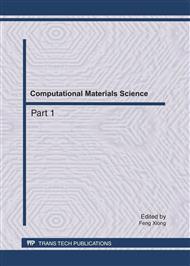[1]
Xintong Wang: Thoughts on to the Ecological Construction of Ulan Buh Region. Forestry Economics, July 2007, pp.49-51, (2007).
Google Scholar
[2]
Tao wan, Ping Cai, Weidong Yi, et al.: RAPD analysis on genetic diversity of nitavia in inner Mongolia. Agricultural Research in the Arid Areas, January 2007, vol. 25, pp.225-229, (2007).
Google Scholar
[3]
Quanlin Ma, Jihe Wang, Dunming zhang, et al.: Physio-ecological characteristics of photosynthesis of endangered plant-Potaninia mongolica. Acta Botanica boreali-occidentalia Sinica, June 1999, Vol. 19, pp.165-170, (1999).
Google Scholar
[4]
S.H. Matthew: A statistical active contour model for SAR image segmentation. Image and Vision Computing, 1999, Vol. 17, pp.213-224, (1999).
DOI: 10.1016/s0262-8856(98)00101-2
Google Scholar
[5]
Tian B., Shaikh M.A., Azimi-Sadjadi M.R., et al.: A Study of Cloud Classification with Neural Networks Using Spectral and Textural Features. IEEE Trans. Neural N etworks, January 1999, Vol. 10, pp.138-151, (1999).
DOI: 10.1109/72.737500
Google Scholar
[6]
Zavaljevski A., Dhawan A.P., GaskilM., et al.: Multi-level Adaptive Segmentation of Multi-parameter MR Brain Images. Computerized Medical Imaging and Graphics, 2000, Vol. 24, pp.87-98, (2000).
DOI: 10.1016/s0895-6111(99)00042-7
Google Scholar
[7]
Marie-Pierre D.J., Sridhar L., Anil K.J.: Vehicle Segmentation and Classification Using Deformable Templates. IEEE Trans. Pattern Analysis and Machine Intelligence, March 1996, Vol. 18, pp.293-308, (1996).
DOI: 10.1109/34.485557
Google Scholar
[8]
Weidong Bai, Jianhua Yan, Yong Chi, et al. Research on Flame Monitoring Based on Image Processing Technology and PCA method. Power Engineering, January 2004, pp.87-90, (2004).
Google Scholar
[9]
Lei F. Tian, David C. Slaughter: Environmentally adaptive segmentation algorithm for outdoor image segmentation. Computers and Electronics in Agriculture, March 1998, Vol. 21, pp.153-168, (1998).
DOI: 10.1016/s0168-1699(98)00037-4
Google Scholar
[10]
Yuzhou Wang, Zongtao Zhao, Xuhong Wang: A Mathematical Morphology-based Segmentation Algorithm for Remotely Sensed Images. Microelectronics & Computer, April 2004, Vol. 21, pp.35-36, (2004).
Google Scholar
[11]
Yujin Zhang: Image Engineering (II) Image Analysis(Second Edition). Tsinghua University Press, China, (2005).
Google Scholar
[12]
Junhui Luo, Ping Feng, et al.: Application in Image Processing by MATLAB 7. 0. Machine Press, China, (2005).
Google Scholar
[13]
Yi Cui: Image processing and analysis - method and application of mathematical morphology. Science Press, China, (2000).
Google Scholar
[14]
Changqing Tang, Hongbo Lv, Zheng Huang, et al.: The method and application of mathematical morphology. Science Press, China, (1990).
Google Scholar
[15]
Serra J.: Image analysis and mathematical morphology. Academic Press, New York, (1982).
Google Scholar


